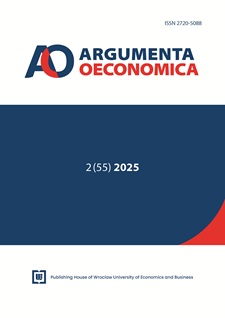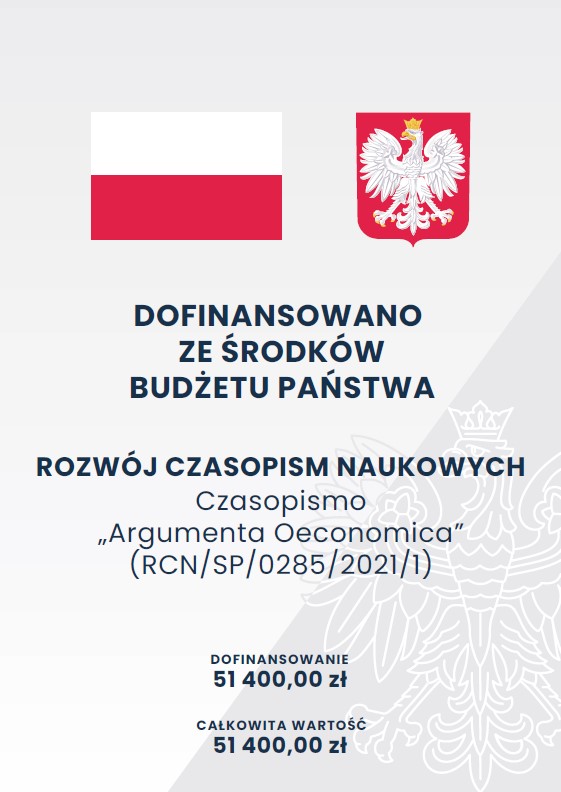Illiquid banks in an overly liquid sector. The impact of liquidity regulation on the deposit policy of listed banks in Poland
DOI:
https://doi.org/10.15611/aoe.2025.2.09Keywords:
monetary policy, banks, liquidity requirements, transmission, deposits, interest ratesAbstract
Aim: The article aimed to show that banks may face liquidity issues even in a structurally over-liquid sector. The relation between monetary policy and liquidity regulations (liquidity coverage ratio, LCR) was outlined, showing that changes in regulatory liquidity, in the form of the surplus over LCR requirement, impact banks’ deposit policy.
Methodology: The author employed qualitative and quantitative data analysis, including dynamic panel data modelling and the calculation of the beta coefficient, presenting the response of deposit policy to changes in the central banks’ reference rate.
Results: It was found that the scale of bank interest rate increases in Poland was visibly higher than in the most of EU countries, among others as a result of the decrease in LCR ratios, which in turn was conditioned by the structural features of the Polish banking sector, namely the high exposure to interest rate risk on securities.
Implications and recommendations: The presence of the macroprudential (liquidity) policy channel may reinforce monetary policy transmission via its impact on banks’ deposit policy.
Originality/value: The article contributes to the emerging literature on the bank deposit channel of monetary policy transmission. Moreover, it outlines a new (liquidity part of the) macroprudential channel of monetary policy transmission and its operation in Poland during the interest rate tightening cycle.
Downloads
References
Arellano, M., & Bond, S. (1991). Some tests of specification for panel data: Monte Carlo evidence and an application to employment equations. The Review of Economic Studies, 58(2), 277-297. https://doi.org/10.2307/2297968
Ariefianto, M. D., Trinugroho, I., Mutmainah, M., & Rahmawati, R. (2015). ALM behavior of banks: Deposit pricing positioning, managerial risk appetite, and money market. Corporate Ownership & Control, 12(4), 91-102. https://doi.org/10.22495/cocv12i4p7
Attila, J. (2022). Does bank deposits volatility react to political instability in developing countries? Finance Research Letters, 49.https:/doi.org/10.1016/j.frl.2022.103126
Bai, J., Krishnamurthy, A., & Weymuller, C.-H. (2018). Measuring liquidity mismatch in the banking sector. The Journal of Finance, 73(1), 51-93, https://doi.org/10.1111/jofi.12591
Bank Gospodarstwa Krajowego. (2024). Annual Financial Statement for 2023. https://www.bgk.pl/files/public/Pliki/Sprawozdanie_finansowe/2024-skonsolidowane/SSF_GK_BGK_2023-12-31_PL.pdf
Banke, N. K., & Yitayaw, M. K. (2022). Deposit mobilization and its determinants: Evidence from commercial banks in Ethiopia. Future Business Journal, 8(1), 1-10. https://doi.org/10.1186/s43093-022-00144-6
Bernanke, B., & Blinder, A. (1988). Credit, money, and aggregate demand. American Economic Review, 78(2), 435-439. https://www.jstor.org/stable/1818164
Bernanke, B., Gertler, M., & Gilchrist, S. (1999). The Financial Accelerator in a Quantitative Business Cycle Framework. Handbook of Macroeconomics, 1(Part C), 1341-1393. https://doi.org/10.1016/S1574-0048(99)10034-X
Bernanke, B., & Lown, C. (1991). The credit crunch. Brookings Papers on Economic Activity, 22(2), 205-247. https://econpapers.repec.org/RePEc:bin:bpeajo:v:22:y:1991:i:1991-2:p:205-248
Bernardelli, M., Korzeb, Z., Niedziółka, P., & Waliszewski, K. (2023). Channels for the impact of the war in Ukraine on the commercial banking sector in Poland: First results of the study. Contemporary Economics, 2023(7), 142-173. http://dx.doi.org/10.5709/ce.1897-9254.504
Beyer, A., Nicoletti, G., Papadopoulou, N., Papsdorf, P., Rünstler, G., Schwarz, C., Sousa, J., & Vergote, O. (2017). The transmission channels of monetary, macro- and micro-prudential policies and their interrelations. ECB Occasional Paper, 191. https://www.ecb.europa.eu/pub/pdf/scpops/ecb.op191.en.pdf
Bikker, J. A., & Gerritsen, D. F. (2018). Determinants of interest rates on time deposits and savings accounts: Macro factors, bank risk, and account features. International Review of Finance, 18(2), 169-216. https://doi.org/10.1111/irfi.12143
Boivin, J., Kiley, M., & Mishkin, F. (2010). How has the monetary transmission mechanism evolved over time? Handbook of Monetary Economics, 3, 369-422. https://doi.org/10.1016/B978-0-444-53238-1.00008-9
Bonner, C., van Lelyveld, I., & Zymek, R. (2015). Banks’ liquidity buffers and the role of liquidity regulation. Journal of Financial Services Research, 48, 215-234. https://doi.org/10.1007/s10693-014-0207-5
Brunnermeier, M. K., Gorton, G., & Krishnamurthy, A. (2012). Risk topography. NBER Macroeconomics Annual, 26, 149-176. https://doi.org/10.1086/663991
Castro, A., Cavallo, M., & Zarutskie, R. (2022). Understanding bank deposit growth during the COVID-19 pandemic, FEDS Notes 03 June. https://www.federalreserve.gov/econres/notes/feds-notes/understanding-bank-deposit-growth-during-the-covid-19-pandemic-20220603.html
Choi, M., & Rocheteau, G. (2023). A model of retail banking and the deposits channel of monetary policy. Journal of Monetary Economics, 139, 127-147. https://doi.org/10.1016/j.jmoneco.2023.06.010
Czaplicki, M. (2022). Measuring the restrictiveness of (macro)prudential policy: The case of bank capital regulation in Poland. Journal of Financial Regulation, 23, 322-338. https://doi.org/10.1057/s41261-021-00164-2
De Graeve, F., De Jonghe, O., & Vander Vennet, R. (2007). Competition, transmission and bank pricing policies: Evidence from Belgian loan and deposit markets. Journal of Banking & Finance, 31(1), 259-278. https://doi.org/10.1016/j.jbankfin.2006.03.003
Demirgüç-Kunt, A., & Huizinga, H. (2004). Market discipline and deposit insurance. Journal of Monetary Economics, 51(2), 375-399. https://doi.org/10.1016/j.jmoneco.2003.04.001
Deutsche Bundesbank (2018). The importance of bank profitability and bank capital for monetary policy. Deutsche Bundesbank Monthly Report, January, 27-52. https://www.bundesbank.de/resource/blob/667588/bf422c75deafad8185444765bf3f722e/mL/2018-01-importance-of-bank-data.pdf
Disyatat, P. (2011). The bank lending channel revisited. Journal of Money, Credit and Banking, 43(4), 711-734. https://www.jstor.org/stable/20870073
Drechsler, I., Savov, A., & Schnabl, P. (2017). The deposits channel of monetary policy. The Quarterly Journal of Economics, 132(4), 1819-1876. https://doi.org/10.1093/qje/qjx019
Drechsler, I., Savov, A., & Schnabl, P. (2021). Banking on deposits: Maturity transformation without interest rate risk. The Journal of Finance, 76(3), 1091-1143. https://doi.org/10.1111/jofi.13013
Dursun-de Neef, H. Ö., & Schandlbauer, A. (2022). COVID-19, bank deposits, and lending. Journal of Empirical Finance, 68, 20-33. https://doi.org/10.1016/j.jempfin.2022.05.003
Fascione, L., Oosterhek, K., Scheubel, B., Stracca, L., & Wildmann, N. (2024). Keep calm, but watch the outliers: Deposit flows in recent crisis episodes and beyond. ECB Occasional Paper No. 361, https://www.ecb.europa.eu/pub/pdf/scpops/ecb.op361~145e704503.en.pdf
Gao, H., Li, J., & Wen, H. (2023). Bank funding costs during the COVID-19 pandemic: Evidence from China. Pacific-Basin Finance Journal, 79. https://doi.org/10.1016/j.pacfin.2023.102006
Gambacorta, L. (2008). How do banks set interest rates? European Economic Review, 52(5), 792-819. https://doi.org/10.1016/j.euroecorev.2007.06.022
Gambacorta, L., & Shin, H. S. (2018). Why bank capital matters for monetary policy. Journal of Financial Intermediation, 35(B), 17-29. https://doi.org/10.1016/j.jfi.2016.09.005
Kapuściński, M. (2017). The role of bank balance sheets in monetary policy transmission: Evidence from Poland. Eastern European Economics, 55(1), 50-69. https://doi.org/10.1080/00128775.2016.1255559
Kapuściński, M. (2024). The short-term effects of changes in capital regulations in Poland. Bank & Credit, 55(3), 255-286. https://bankikredyt.nbp.pl/content/2024/03/BIK_03_2024_02.pdf
Kashyap, A., & Stein, J. (1995). The impact of monetary policy on bank balance sheets. Carnegie-Rochester Conference Series on Public Policy, 42, 151-195. https://doi.org/10.1016/0167-2231(95)00032-U
Kho, S. (2024). Deposit market concentration and monetary transmission: Evidence from the euro area. ECB Working Paper No. 2896. https://www.ecb.europa.eu/pub/pdf/scpwps/ecb.wp2896~92bba6983d.en.pdf
McLeay, M., Radia, A., & Thomas, R. (2014). Money creation in the modern economy. Bank of England Quarterly Bulletin, 2014 Q1, 14-27. https://papers.ssrn.com/sol3/papers.cfm?abstract_id=2416234
Messer, T., & Niepmann, F. (2023). What determines passthrough of policy rates to deposit rates in the euro area? FEDS Note, 28 July. https://www.federalreserve.gov/econres/notes/feds-notes/what-determines-passthrough-of-policy-rates-to-deposit-rates-in-the-euro-area-20230728.html
Mondschean, T. S., & Opiela, T. P. (1999). Bank time deposit rates and market discipline in Poland: The impact of state ownership and deposit insurance reform. Journal of Financial Services Research, 15, 179-196. https://doi.org/10.1023/A:1008140716508
National Bank of Poland (2023). Report on monetary policy. https://nbp.pl/wp-content/uploads/2023/05/Report-on-monetary-policy-in-2022.pdf
Pattipeilohy, C. (2013). Spaarrentes en het depositofinancieringsgat. Economisch-Statistische Berichten, 98, 298-300. https://esb.nu/spaarrentes-en-het-depositofinancieringsgat/
Przybylska-Kapuścińska, W. (2003). Operacje otwartego rynku w Polsce w latach 1993-2002. Ruch Prawniczy, Ekonomiczny i Socjologiczny, 65(4), 89-116. https://repozytorium.amu.edu.pl/server/api/core/bitstreams/26e3ddf1-d536-4b11-8b02-7fcff197f94a/content
Tran, S. V., & Nguyen, T. C., & Hoang, H. V. (2024). The impact of the COVID-19 pandemic on bank funding costs. Finance Research Letters, 67 Part B. https://doi.org/10.1016/j.frl.2024.105943
Van der Heuvel, S. (2002). Does bank capital matter for monetary transmission? Federal Reserve Bank of New York Economic Policy Review, 8(May). https://www.newyorkfed.org/medialibrary/media/research/epr/02v08n1/0205vand.pdf
Van der Heuvel, S. (2006). The bank capital channel of monetary policy. Society for Economic Dynamics 2006 Meeting Papers No. 512. https://ideas.repec.org/p/red/sed006/512.html
Vodová, P. (2013). Liquidity ratios of Polish commercial banks. European Financial and Accounting Journal, 8(3), 24-38. https://doi.org/10.18267/j.efaj.105
Downloads
Published
License
Copyright (c) 2025 Marcin Czaplicki

This work is licensed under a Creative Commons Attribution-ShareAlike 4.0 International License.
Accepted 2025-04-15
Published 2025-09-30








